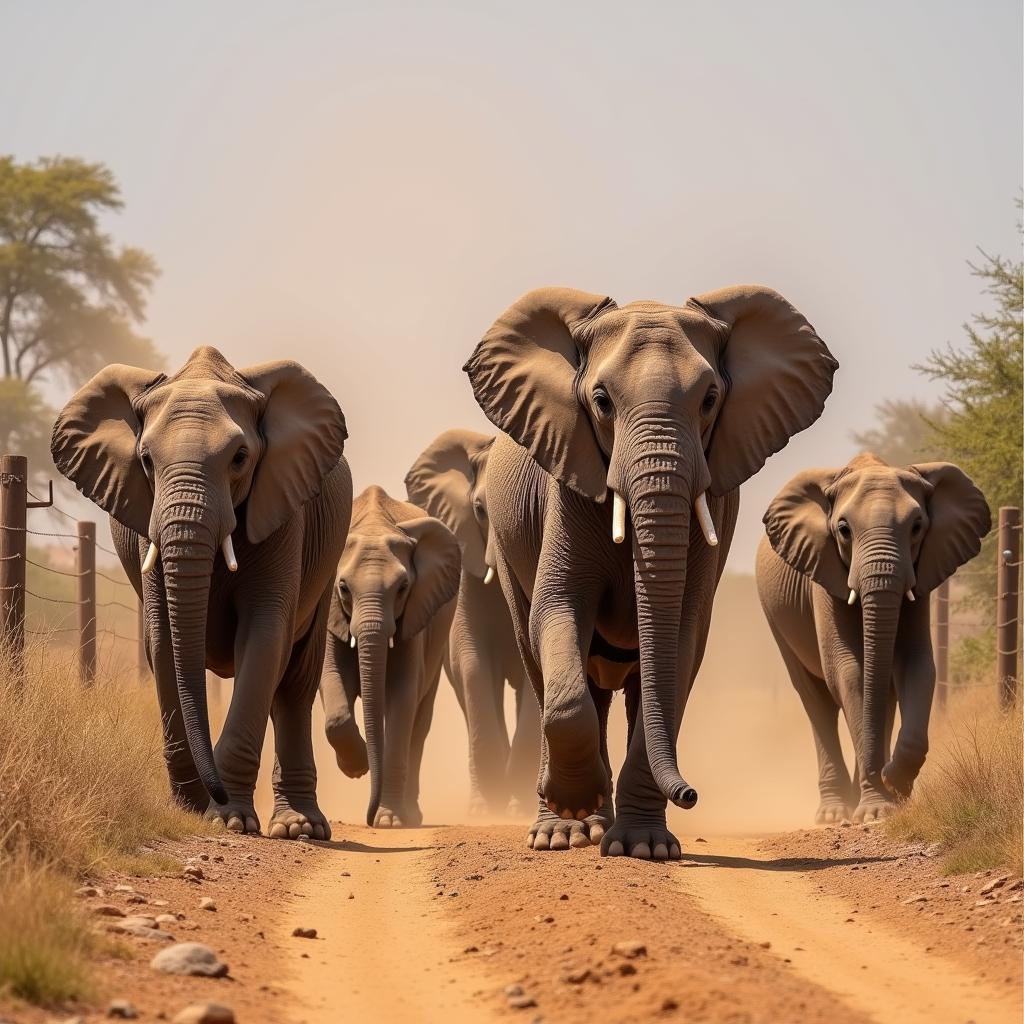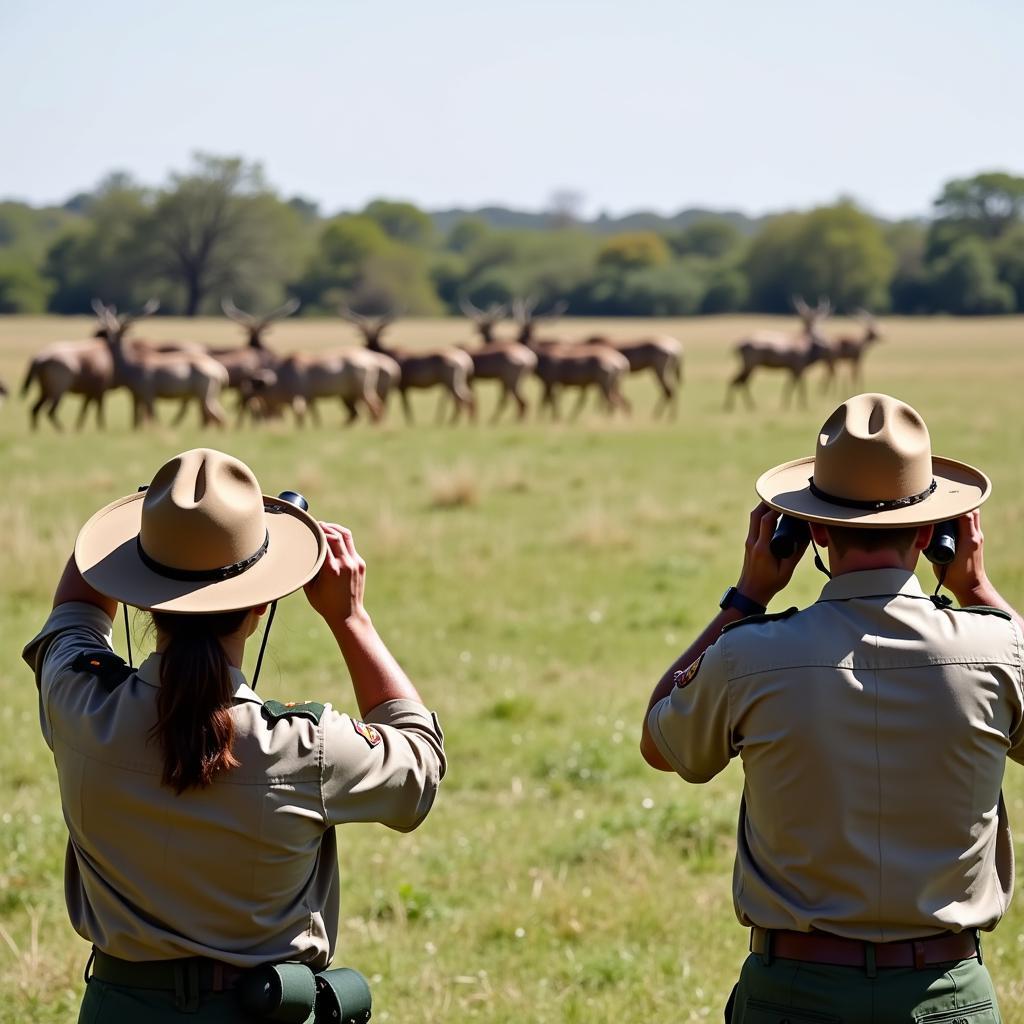The Shrinking World of African Elephants: Understanding Habitat Fragmentation
African elephants, the magnificent giants of the savanna, face a growing threat: habitat fragmentation. This occurs when their once vast landscapes are carved up by human activities, leaving elephants confined to smaller and more isolated pockets of land. This fragmentation has dire consequences for the elephants and the delicate ecosystems they inhabit.
 An African elephant family navigating a fragmented landscape
An African elephant family navigating a fragmented landscape
The Root of the Problem: Causes of Habitat Fragmentation
The driving forces behind habitat fragmentation in Africa are complex and interconnected:
- Human Population Growth: As Africa’s population rapidly expands, so does the demand for land. This leads to the conversion of natural habitats into farms, settlements, and infrastructure.
- Agriculture: The expansion of agriculture, particularly large-scale farming, is a leading cause of habitat loss and fragmentation.
- Logging and Mining: These industries clear vast areas of forests and disrupt natural landscapes, fragmenting elephant habitats.
- Infrastructure Development: The construction of roads, railways, and pipelines creates barriers within elephant territories, restricting their movement.
A Cascade of Consequences: The Impact on Elephants
Habitat fragmentation creates a ripple effect of negative consequences for African elephants:
- Limited Resources: Smaller habitat patches support fewer elephants and offer less food and water, leading to competition and potential starvation.
- Restricted Movement: Elephants are migratory animals that travel long distances. Fragmentation restricts their ability to find mates, access resources, and maintain genetic diversity.
- Increased Human-Elephant Conflict: As elephants are forced closer to human settlements in search of resources, conflicts become more frequent. This can lead to crop raiding, property damage, and even loss of life for both humans and elephants.
- Disease Transmission: Fragmentation can concentrate elephant populations, making them more susceptible to disease outbreaks, which can spread more easily and have devastating effects.
A Glimmer of Hope: Conservation Strategies
Protecting African elephants from the threat of habitat fragmentation requires a multi-faceted approach:
- Protected Areas: Establishing and effectively managing protected areas, such as national parks and wildlife reserves, is crucial to safeguard elephant habitats.
- Wildlife Corridors: Creating corridors that connect fragmented habitats allows elephants to move freely, access resources, and maintain genetic diversity.
- Community-Based Conservation: Engaging local communities in conservation efforts is essential. This can involve promoting sustainable land management practices, providing alternative livelihoods, and fostering a sense of shared responsibility for elephant conservation.
- Anti-Poaching Initiatives: Combating poaching and the illegal ivory trade is critical to ensure the survival of African elephants.
The Role of Education and Awareness
Raising awareness about the importance of elephant conservation and the threats they face is vital:
- Educating Future Generations: Integrating conservation messages into school curricula can help foster a sense of stewardship for elephants and their habitats among young people.
- Promoting Responsible Tourism: Encouraging tourists to support ethical and sustainable tourism operators that prioritize elephant conservation can make a difference.
- Supporting Conservation Organizations: Numerous organizations are working tirelessly to protect African elephants. Donations and volunteer work can contribute significantly to these efforts.
FAQs About African Elephant Habitat Fragmentation
1. What is the biggest threat to African elephants today?
While poaching for ivory remains a serious concern, habitat loss and fragmentation are increasingly recognized as the most significant threats to the long-term survival of African elephants.
2. How can I help reduce habitat fragmentation?
You can support organizations working on elephant conservation, reduce your own ecological footprint by consuming responsibly, and raise awareness about the issue among your peers.
3. Are wildlife corridors effective?
Yes, wildlife corridors have proven to be a valuable tool in mitigating the impacts of habitat fragmentation. They allow elephants to move more freely, access resources, and maintain genetic diversity.
african country where gold is found
Beyond Fragmentation: A Future for African Elephants
The plight of African elephants highlights the delicate balance between human development and wildlife conservation. By addressing the root causes of habitat fragmentation and implementing effective conservation strategies, we can help ensure a future where these magnificent creatures continue to roam free. Each of us has a role to play in protecting African elephants and preserving their shrinking world for generations to come.
Remember, the future of African elephants depends on our collective action.
Need support? Contact us:
- Phone: +255768904061
- Email: kaka.mag@gmail.com
- Visit us: Mbarali DC Mawindi, Kangaga, Tanzania
We have a dedicated customer support team available 24/7.


